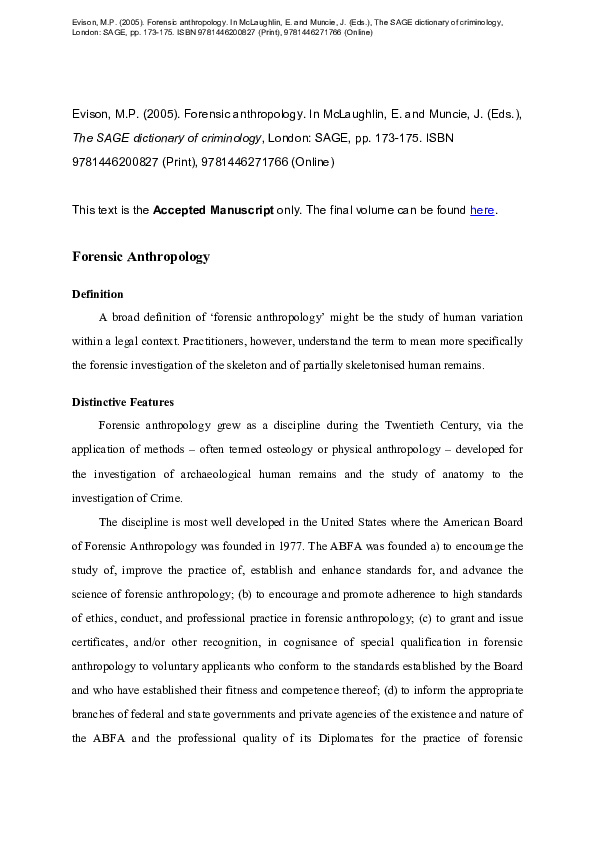Academia.edu no longer supports Internet Explorer.
To browse Academia.edu and the wider internet faster and more securely, please take a few seconds to upgrade your browser.
Forensic anthropology
Forensic anthropology
2005, McLaughlin, E. and Muncie, J. (Eds.), The SAGE dictionary of criminology, London: SAGE, p. 173-5. ISBN 9781446200827 (Print), 9781446271766 (Online)
Related Papers
2021 •
This paper explores the current state of forensic anthropology in the United States as a distinct discipline. Forensic anthropology has become increasingly specialized and the need for strengthened professionalization is becoming paramount. This includes a need for clearly defined qualifications, training, standards of practice, certification processes, and ethical guidelines. Within this discussion, the concept of expertise is explored in relation to professionalization and practice, as both bioarchaeology and forensic anthropology have different areas of specialist knowledge, and therefore unique expertise. As working outside one’s area of expertise is an ethical violation, it is important for professional organizations to outline requisite qualifications, develop standards and best practice guidelines, and enforce robust preventive ethical codes in order to serve both their professional members and relevant stakeholders.
Soc. Anatomy Espanola (Spanish Soc. of Anatomy)
Redefining forensic anthropology in the 21st century and its role in mass fatality investigations2021 •
Golden Meteorite Press
Forensic Anthropology: An Uncovering2021 •
Austin A Mardon, Anittha Mappanasingam, Anusha A Mappanasingam, Samira Sunderji, Sheher-Bano Ahmed, Sean Lyeo, Sam Zhang
Forensic anthropology is a sub-discipline of anthropology which employs anthropological teachings to solve crimes. Thanks to countless inaccurate media portrayals, the work of a forensic anthropologist is shrouded in misinformation and mysticism. Read on to learn more about the truth behind the fiction, including the science behind forensic anthropology, its history, and what a typical day looks like for a forensic anthropologist.
The history of forensic anthropology has been documented by numerous scholars. These contributions have described the work of early pioneers in the field and have described important milestones, such as the founding of the Physical Anthropology Section of the Amer-ican Academy of Forensic Sciences (AAFS) in 1972 and the American Board of Forensic Anthropology (ABFA) in 1977. This paper contributes to the growing literature on the history of forensic anthropology by documenting the academic training of all individuals who have been granted diplomate status by the ABFA (n = 115). Doctoral dissertation titles were queried to discern broad patterns of research foci. A total of 39 doctoral granting institutions have trained diplomates and 77.3% of board-certified forensic anthropologists wrote dissertations involving skeletal biology, bioarchaeology, or forensic anthropology. Board-certified forensic anthropologists are a broadly trained group of professionals with far-reaching anthropological interests and expertise.
Journal of Contemporary Anthropology
A Look at the History of Forensic Anthropology: Tracing My Academic Genealogy2010 •
American Anthropologist
A conversation on redefining ethical considerations in forensic anthropology2022 •
American Journal of Physical Anthropology
New perspectives in forensic anthropology2008 •
A critical review of the conceptual and practical evolution of forensic anthropology during the last two decades serves to identify two key external factors and four tightly inter-related internal methodological advances that have significantly affected the discipline. These key developments have not only altered the current practice of forensic anthropology, but also its goals, objectives, scope, and definition. The development of DNA analysis techniques served to undermine the classic role of forensic anthropology as a field almost exclusively focused on victim identification. The introduction of the Daubert criteria in the courtroom presentation of scientific testimony accompanied the development of new human comparative samples and tools for data analysis and sharing, resulting in a vastly enhanced role for quantitative methods in human skeletal analysis. Additionally, new questions asked of forensic anthropologists, beyond identity, required sound scientific bases and expanded the scope of the field. This environment favored the incipient development of the interrelated fields of forensic taphonomy, forensic archaeology, and forensic trauma analysis, fields concerned with the reconstruction of events surrounding death. Far from representing the mere addition of new methodological techniques, these disciplines (especially, forensic taphonomy) provide forensic anthropology with a new conceptual framework, which is broader, deeper, and more solidly entrenched in the natural sciences. It is argued that this new framework represents a true paradigm shift, as it modifies not only the way in which classic forensic anthropological questions are answered, but also the goals and tasks of forensic anthropologists, and their perception of what can be considered a legitimate question or problem to be answered within the field. Yrbk Phys Anthropol 51:33–52, 2008. © 2008 Wiley-Liss, Inc.
RELATED PAPERS
2021 •
Mehran University Research Journal of Engineering and Technology
Protector: A Permanent Fault Resilient Router Architecture for Network on Chip2020 •
JPPI (Jurnal Penelitian Pendidikan Indonesia)
Penerapan model Group Investigation (GI) dalam pembelajaran analisis kasus pelanggaran Undang-Undang ITESurgical Endoscopy and Other Interventional Techniques
Safety of laparoscopic hepatectomy in patients with hepatocellular carcinoma and portal hypertension: interim analysis of an open prospective study2018 •
International Journal of Environmental Research and Public Health
Anorexia Nervosa, Body Image Perception and Virtual Reality Therapeutic Applications: State of the Art and Operational ProposalTeaching and Teacher Education
Does teaching on the "Other" side create a change2019 •
International Journal of Emerging Electric Power Systems
Unit Commitment of Hydro Dominated Systems
 Martin Evison
Martin Evison